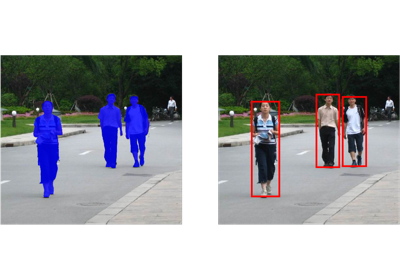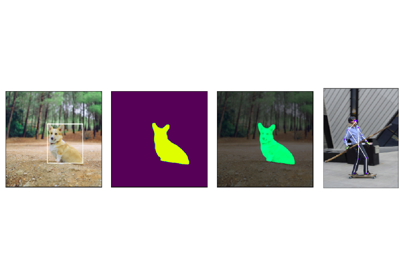fasterrcnn_resnet50_fpn
-
torchvision.models.detection.fasterrcnn_resnet50_fpn(pretrained=False, progress=True, num_classes=91, pretrained_backbone=True, trainable_backbone_layers=None, **kwargs)[source] Constructs a Faster R-CNN model with a ResNet-50-FPN backbone.
Reference: “Faster R-CNN: Towards Real-Time Object Detection with Region Proposal Networks”.
The input to the model is expected to be a list of tensors, each of shape
[C, H, W], one for each image, and should be in0-1range. Different images can have different sizes.The behavior of the model changes depending if it is in training or evaluation mode.
During training, the model expects both the input tensors, as well as a targets (list of dictionary), containing:
boxes (
FloatTensor[N, 4]): the ground-truth boxes in[x1, y1, x2, y2]format, with0 <= x1 < x2 <= Wand0 <= y1 < y2 <= H.labels (
Int64Tensor[N]): the class label for each ground-truth box
The model returns a
Dict[Tensor]during training, containing the classification and regression losses for both the RPN and the R-CNN.During inference, the model requires only the input tensors, and returns the post-processed predictions as a
List[Dict[Tensor]], one for each input image. The fields of theDictare as follows, whereNis the number of detections:boxes (
FloatTensor[N, 4]): the predicted boxes in[x1, y1, x2, y2]format, with0 <= x1 < x2 <= Wand0 <= y1 < y2 <= H.labels (
Int64Tensor[N]): the predicted labels for each detectionscores (
Tensor[N]): the scores of each detection
For more details on the output, you may refer to Instance segmentation models.
Faster R-CNN is exportable to ONNX for a fixed batch size with inputs images of fixed size.
Example:
>>> model = torchvision.models.detection.fasterrcnn_resnet50_fpn(pretrained=True) >>> # For training >>> images, boxes = torch.rand(4, 3, 600, 1200), torch.rand(4, 11, 4) >>> boxes[:, :, 2:4] = boxes[:, :, 0:2] + boxes[:, :, 2:4] >>> labels = torch.randint(1, 91, (4, 11)) >>> images = list(image for image in images) >>> targets = [] >>> for i in range(len(images)): >>> d = {} >>> d['boxes'] = boxes[i] >>> d['labels'] = labels[i] >>> targets.append(d) >>> output = model(images, targets) >>> # For inference >>> model.eval() >>> x = [torch.rand(3, 300, 400), torch.rand(3, 500, 400)] >>> predictions = model(x) >>> >>> # optionally, if you want to export the model to ONNX: >>> torch.onnx.export(model, x, "faster_rcnn.onnx", opset_version = 11)
- Parameters
pretrained (bool) – If True, returns a model pre-trained on COCO train2017
progress (bool) – If True, displays a progress bar of the download to stderr
num_classes (int) – number of output classes of the model (including the background)
pretrained_backbone (bool) – If True, returns a model with backbone pre-trained on Imagenet
trainable_backbone_layers (int) – number of trainable (not frozen) resnet layers starting from final block. Valid values are between 0 and 5, with 5 meaning all backbone layers are trainable. If
Noneis passed (the default) this value is set to 3.
Examples using
fasterrcnn_resnet50_fpn:


